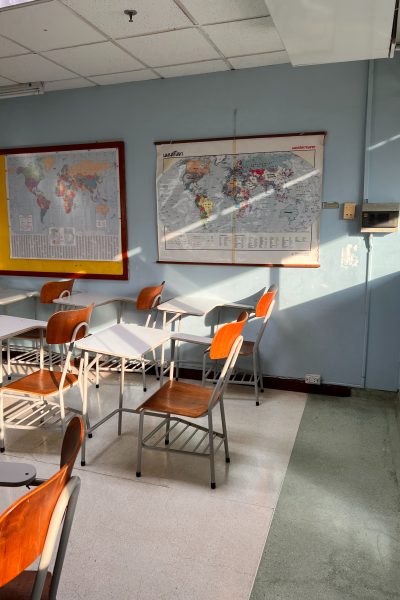
Let’s face it… classroom management is not as easy as it sounds, especially in the FSL classroom. Technology distractions, large class sizes, varying levels of proficiency, and behavior issues all pose problems to the “desired classroom environment” and on top of that, our students often struggle with the language barrier as they learn a new language. However, as educators, we cannot deny that classroom management is essential for creating an environment conducive to effective teaching and learning. It lays the foundation for a positive and inclusive atmosphere where students can engage with the material, interact with their peers, and develop the skills necessary for academic success and personal growth. In this blog post, we will explore effective classroom management strategies that will inspire you to cultivate a positive and productive learning environment for your students and keep you sane in the process!
Classroom Management Strategies Vary Based On Classes
Firstly, I want to acknowledge that there isn’t a “one size fits all approach” when it comes to classroom management. Some classroom management strategies work seamlessly in one classroom and require adjustments in another, especially in the unique context of teaching French as a Second Language. Mastering classroom management in the FSL setting requires a nuanced approach that considers language acquisition, cultural sensitivity, and the diverse backgrounds of language learners. Over time, you will also find yourself more knowledgeable about the strategies and skills that work with your teaching style and personality. Now, let’s dive into some essential classroom management strategies that you can start implementing in your classroom today!

Set Those Expectations Day 1!
One of the fundamental aspects of successful classroom management is establishing clear expectations. I cannot stress the importance of classroom expectations enough! Communicate your classroom rules, routines, and academic standards from the very beginning and you will make your life so much easier. This proactive approach lays the foundation for a positive and well-organized learning environment. Students thrive when they understand what is expected of them, both behaviorally and academically. Take the time to articulate these expectations clearly and have them posted in a place where students can see them in your classroom all year or semester long.
When setting the expectations, there are two ways that you can do this:
- Make the expectations together as a class by encouraging student input. This creative way helps foster a sense of ownership and responsibility amongst your students. Therefore, they are more likely to adhere to the expectations you’ve made collectively
- Have the expectations pre-made and then show them to the class. This is the option I usually do with my high school students to establish authority and set a tone of professionalism and academic seriousness
No matter how you decide to set the expectations, make sure that they are limited to five and posted in the classroom, visible to all students. Therefore, you can resort back to these expectations throughout the lesson and year if needed. You will also want to make sure that the expectations are realistic, age-appropriate, and aligned with the goals of your teaching. As the academic year progresses, revisit and revise expectations if necessary, allowing flexibility to accommodate the evolving dynamics of the classroom. In doing so, you not only create a framework for effective classroom management but also establish a culture of respect, responsibility, and a mutual understanding that will benefit both you and your students throughout the entire school year.
Building Positive Relationships - Literally the Key to Success

Cultivating positive relationships with your students is essential to a well-managed classroom. Take the time to get to know your students as individuals, understand their interests, and be attentive to their well-being. These positive relationships will win your students over and create a sense of community and belonging in the classroom. Moreover, when you demonstrate genuine care for their well-being, you also establish trust and rapport with your learners. When students feel valued and understood, they are more likely to respond positively to your guidance, making it easier to address behavioral issues with empathy and collaboration.
In addition, positive relationships contribute to a positive learning environment that extends beyond the academic realm. Students who feel supported emotionally are more resilient and better equipped to navigate the challenges of the learning process. As a result, the classroom becomes a space where mistakes are seen as opportunities for growth, and challenges are approached with a growth mindset. These positive relationships not only enhance the overall learning experience but also create a community of learners who support each other, fostering a collaborative and inclusive environment.
One tip that I would strongly recommend would be to get your students to fill out a student profile at the beginning of the semester. Then you can read through them all and use that information to start conversations with your learners and build rapport. This has been an essential task that I incorporate in my classes the first week and can vouch that it is the catalyst for building those positive relationships! Looking for a free student profile to get to know your students at the beginning of the semester? Check out these editable examples below:
Utilizing Consistent and Fair Discipline
Discipline can sound like an intimidating concept but I can assure you that it is a necessary aspect of classroom management. The important thing to note is that discipline must be consistent and fair. Clearly outline consequences for negative behavior and be sure to follow through. Following through is extremely important in order for your students to take you seriously and this action gives power to your words. When students see that the rules apply to everyone and are enforced without bias, they are more likely to respect both the rules and the authority figure implementing them. This consistency sends a powerful message about the importance of responsibility and accountability, fostering a sense of order and security within the learning environment.
When discipline is necessary, there are a couple of options that you can consider:
- Private Conversations – for minor behavioral issues, consider addressing the student privately. Having a one-on-one conversation allows you to understand the student’s perspective and helps build a positive relationship. It also provides an opportunity for the student to reflect on their actions.
- Behavior Contracts – for addressing minor to moderately serious issues, where a student will take ownership of their behavior and set goals that align with the class expectations. These contracts can also be sent home for a parent to see and sign off on.
- Detention – usually my last resort but you can consider giving detention to a student and clearly communicate the reasons for these consequences so that the student is able to reflect on their actions.
Whatever discipline method you choose, keep in mind that consistency helps students understand the expectations and reinforces the importance of responsible behavior.
Engaging Lessons and Varied Activities
Furthermore, the importance of engaging lessons and varied activities cannot be overstated. These elements not only serve as powerful tools for capturing your students’ attention but also play a crucial role in fostering a positive and dynamic learning environment. When lessons are thoughtfully designed to be interactive, challenging, and authentic, students are more likely to stay focused and actively participate in the learning process.
Varied activities can include group discussions, passion projects, multimedia presentations, role-play scenarios, language games, virtual field trips, artistic creations, debates, and more. These distinct learning opportunities will cater to diverse learning styles and ensure that each student has an opportunity to excel. You can also teach content related to your students’ interests. This will solidify their engagement, spark their curiosity, and motivate them to learn. In this way, you create a space where students are not just passive recipients of information but active contributors to their own educational journey.

Encouraging Student Responsibility
Encouraging student responsibility is not just a noble aspiration; it’s a cornerstone of effective classroom management. In a well-managed classroom, the teacher will gradually shift responsibility to their students by giving them opportunities to take ownership of their learning. When implementing this strategy in your own class, create opportunities for student self-reflection, goal-setting, and self-assessment options. As students become more responsible for their own progress, the need for constant teacher interventions diminishes. They will feel accountable for their actions and contributions and this translates to a more harmonious and productive learning space. As students embrace responsibility, they become active participants in their learning journey and take charge of their education.
Effective and Continual Communication with Parents
One last effective classroom management strategy relates to effective and continual communication with parents. They are your support partners on the home front! You want to keep parents informed about your classroom expectations, upcoming assignments, and their child’s progress. You want to establish open lines of communication and be proactive in addressing any concerns. Keep the dialogue open and also contact in efforts to praise their child’s effort as well. Parents can also be a valuable source of information regarding their child’s background, including their interests, strengths, challenges, and any special needs that they may have. Establishing a partnership with parents reinforces a consistent approach between home and school and creates a supportive network for student success.
Conclusion
In conclusion, effective classroom management is essential in the FSL classroom, playing a fundamental role in creating an environment conducive to language acquisition and overall student success. A well-managed classroom facilitates the teaching and learning process and also fosters a positive and engaging atmosphere where students feel comfortable taking risks in French.
Remember that effective classroom management is an ongoing process that evolves with each unique group of students. Stay adaptable, reflective, and committed to creating a positive and enriching educational experience for your students. Bonne chance!

P.S. Starting a new semester and need some fresh tips to ensure a smooth transition? Check out my blog post: 10 Essential Teaching Tips Before Starting a New Semester.
